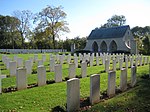Villa Louis, Lion-sur-Mer
1864 establishments in France20th-century architecture in FranceArt Nouveau architecture in FranceArt Nouveau housesBuildings and structures in Calvados (department) ... and 2 more
Houses completed in 1903Houses in France
La Villa Louis in Lion-sur-Mer, Normandy, France, was built in 1864 for Pierre Joseph Pasquet to be used as a casino. In 1903 he married Elisa Auber, Daniel Auber's daughter, and modify the building to be use as a villa. The French architect Jean Alexandre Navarre add the first floor with the Art-Nouveau loggia on the sea side. The ceramics of the both side of the house are the works of Alexandre Bigot. It is a listed historical monument since 1998.
Excerpt from the Wikipedia article Villa Louis, Lion-sur-Mer (License: CC BY-SA 3.0, Authors).Villa Louis, Lion-sur-Mer
Rue Joseph Pasquet, Caen
Geographical coordinates (GPS) Address External links Nearby Places Show on map
Geographical coordinates (GPS)
| Latitude | Longitude |
|---|---|
| N 49.303 ° | E -0.3156 ° |
Address
Maison Louis (Castel Louis)
Rue Joseph Pasquet 4
14780 Caen
Normandy, France
Open on Google Maps











